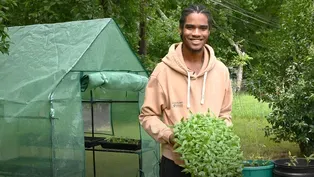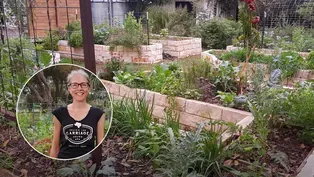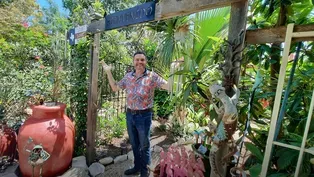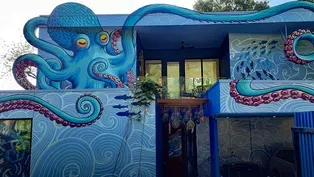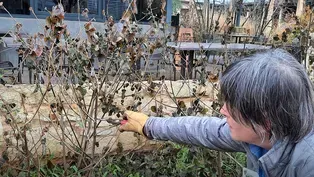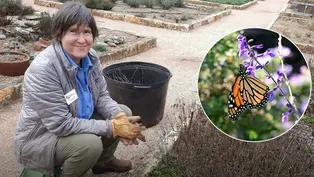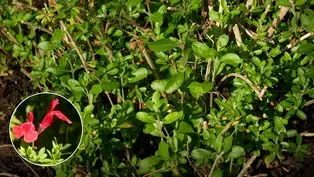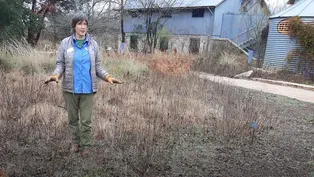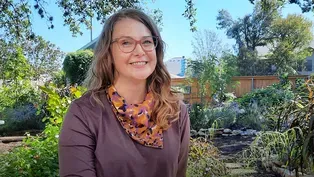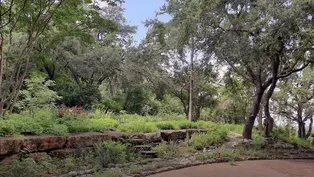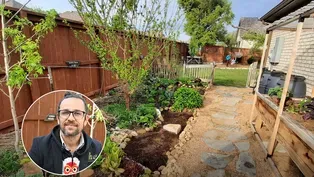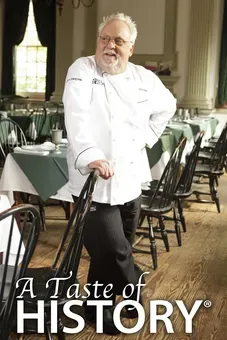
Permaculture Design: Raised Beds and Food Forest
Clip: Season 28 | 9m 15sVideo has Closed Captions
Limestone raised beds and a mandala-designed food forest honor resourceful permaculture tenets.
Framed by historic live oak trees in cozy Lockhart, limestone raised beds and a mandala-designed food forest honor resourceful permaculture tenets to nourish families and wildlife. New gardener Donna Daniels and husband Len Gabbay grew from Austin Permaculture Guild co-director Taelor Monroe’s design and berm and swales that direct rainwater to perennial food, flowers, and fruit trees.
Problems with Closed Captions? Closed Captioning Feedback
Problems with Closed Captions? Closed Captioning Feedback
Central Texas Gardener is a local public television program presented by Austin PBS
Support for CTG is provided by: Lisa & Desi Rhoden, and Diane Land & Steve Adler. Central Texas Gardener is produced by Austin PBS, KLRU-TV and distributed by NETA.

Permaculture Design: Raised Beds and Food Forest
Clip: Season 28 | 9m 15sVideo has Closed Captions
Framed by historic live oak trees in cozy Lockhart, limestone raised beds and a mandala-designed food forest honor resourceful permaculture tenets to nourish families and wildlife. New gardener Donna Daniels and husband Len Gabbay grew from Austin Permaculture Guild co-director Taelor Monroe’s design and berm and swales that direct rainwater to perennial food, flowers, and fruit trees.
Problems with Closed Captions? Closed Captioning Feedback
How to Watch Central Texas Gardener
Central Texas Gardener is available to stream on pbs.org and the free PBS App, available on iPhone, Apple TV, Android TV, Android smartphones, Amazon Fire TV, Amazon Fire Tablet, Roku, Samsung Smart TV, and Vizio.
Providing Support for PBS.org
Learn Moreabout PBS online sponsorship- My philosophy on this garden, I started out wanting to grow food for my husband and I, and then I figured out I enjoy growing the food for the insects and the bees and the butterflies the most.
Hi, my name is Donna Daniels.
I live here with my husband, Len Gabay.
We bought the property in 2019 and we had some raised beds that were already here.
Over there in the permaculture garden, we had a big cement pad and we wanted to tear that out and put a garden in.
And so we called Taelor and said, let's do this.
- I'm Taelor Monroe and I am the co-owner of the Austin Permaculture Guild and executive director and yeah, permaculture.
It is a system for sustainable design.
So it's a design science and it takes a holistic view of everything really, and kind of boils it down into mimicking nature.
That's what permaculture's all about.
And I came in here and they had just removed a concrete slab back here and they said, Taelor, what do we do with that spot?
And I got really excited because it's so fun to have a blank slate scenario where I can just dream up whatever I want, basically, and they're down.
So I thought it would be so beautiful to do a food forest here.
We have huge live oaks, 300 year-old right here at the base of this garden in between the house and then a few pecan trees as well.
So that was definitely interesting to design around.
So we made sure to put in shade loving species right there under the canopy of the oak.
But, right, you know, we got right up close to the edge with other species that need full sun.
We have all intermixed in here fruit trees with all the support species.
So we have dynamic accumulators, things like yarrow and comfrey and other culinary and medicinal herbs and of course planting for the wildlife as well.
Permaculture really focuses on a lot of perennial food systems so that, you know, you're not, it's not as much labor, right, because fruit trees, they do take time, of course, to establish, but once they're established, they're just producing food for you.
And so thinking about those specific plants that are going to keep producing without you having to replant every season are really great.
And so medicinal herbs, culinary herbs, asparagus, artichoke, perennial leeks and chives and onions and, you know, things like that make it really easy to plan for the future.
- When we did move in, we had quite a bit of flooding.
It would rip through the property, come right through here, shoot through that fence, and it would take all the topsoil off of our neighbor's house.
- And I really wanted to work with the water and I wanted it to be really beautiful at the same time.
So what ended up is this mandala garden, berm and swale.
Berms and swales are a strategy within permaculture design that we designed the, basically a swale is a ditch on contour and so it runs perpendicular to the natural flow of water is how a traditional berm and swale is organized.
And then the berm is downhill of the swale and intercepts that water and acts like a little a little catchment area for that water to go into.
Where they removed this concrete pad, there was already an indentation in this entire area here.
And so I knew that water was going to infiltrate this spot.
And so instead of doing the traditional design where we have those berms and swales perpendicular, it's more of a mandala shape that actually the swale is act as pathways, which they do in the traditional sense.
- It's kind of cool because it has these little paths.
So the water runs through there, it collects, it pools up, and then after a day or two, it just naturally soaks into the ground Now, I'm really proud that we've been able to mitigate most of that water and keep it here on the property.
It comes through here and there's a low point right there where we have a big vetiver, and vetiver has giant tap roots.
So the hope was and is that it stops there and that sucks up the very last of the water that used to shoot to our neighbor's house.
And our last dream to make this place complete was to put in a water, a rainwater collection system.
So we put in a 10,000 gallon system.
For 20, almost 25 years, I was an esthetician.
So I've always used my hands to express myself and work on people.
And then during COVID, I shut my business down.
And so that's when I really got into gardening and learned everything about gardening because I could use my hands with gardening.
And I had no gardening experience at that point.
So I've done all of this in three years with my husband and we figured it out and we love it.
So vertical gardening is really where it's at.
You can get so much garden space by going up.
These trellises back here, we tried to do them a little cheaper.
So it's just fencing.
Fencing is a little cheaper than the cattle panel or it was at the time.
This is the cattle panel.
But with the fencing, what I found, it's very hard.
I can't get my hands through it.
So it's a little more difficult to work with and it's not as strong.
I grew pumpkins on this trellis one year and it almost tore it down.
So if you can, I would go with the cattle panel because you can get your hands through it.
That's one luffa plant.
We got so many luffas off of that.
And then it started to dry up with this weather.
The plant had just lived the cycle of its life, so I tore the vines down, but I left the luffas where they are, so hopefully they'll dry in place.
And it just happens to look kind of whimsical and cool.
So it was a happy accident.
That's where I'm really going with gardening is happy accidents and if things want to volunteer, that's a free source of food.
I'm not going to pull that volunteer out.
I'm going to say thanks.
You can grow here.
And that's why I have so many crazy combinations of things going on in the beds because it's stuff that I've planted, it's volunteers, and then a lot of people, when they reset their fall gardens, they would pull all of this basil out.
I can't bear to do that because it's still making flowers.
The bees are still enjoying it and I can still enjoy it.
So that's not the kind of gardener I am.
I'm going to leave it in until it finishes its life cycle.
And so that makes it a lot less structured.
So it might drive you crazy if you're a super structured person, you might not be able to live with it like that.
But I have more of a wild style, so it works for me.
This lamb's quarter, I bought one one year, I let it grow.
It went to seed and now it just reseeds everywhere in the garden.
I had no idea that they would get this big.
They do.
I let anything pretty much in the garden or the lawn volunteer because this could be a food source if I ever needed an emergency food source.
And it goes, it grows naturally and it grows free.
The other thing I found with gardening, if you make it beautiful, then there's a reason for you to be out there.
And I love this.
I think of it as a little waystation for insects that they can come and everyone's welcome here.
And I try to have something for everyone to munch on.
So the first year I grew artichokes, I didn't realize that they open up to these beautiful flowers and the bees love them.
So I looked it up and the symbol of an artichoke is peace, hope and prosperity.
And I love that so much and I believe in it.
So I have artichokes planted everywhere in this garden.
This is what your organic gardening tools are because you're going to have to pick off caterpillars and the worms and you're going to have to do it every day.
And that's just gardening Our compost pile I'm very proud of.
I do have the oldest to the newest compost pile.
So the oldest one is just sitting there getting nice and soily.
And then of course, just the newer ones have all the stuff on them that haven't decomposed yet.
- And, you know, even if you don't have a whole acre to plant, there's so many great resources in Austin, in central Texas, for our community gardening, even having pots on your back porch, even just growing culinary herbs.
Culinary herbs can be so medicinal in your daily diet.
One one reason that I believe so strongly in our permaculture design principles is definitely for our future generations.
I do have a kiddo and I am very involved with the kiddos and the coming generations and that's one of our main tenets is looking towards the next not just 50 years but the next seven generations, you know, just like our indigenous did.
- Because check this out.
This is beautiful.
(light music)
Growing Community: Body and Soul
Video has Closed Captions
Lenny West found his anchor and mission in providing fresh vegetables to food desert neighbors. (6m 18s)
Native Plant Garden in HOA: Martin Byhower
Video has Closed Captions
A California-to-Texas environmentalist helps neighbors garden for wildlife in extreme weather. (8m 42s)
Permaculture Design: Raised Beds and Food Forest
Video has Closed Captions
Limestone raised beds and a mandala-designed food forest honor resourceful permaculture tenets. (9m 15s)
Creating Moods in a Regular Backyard
Video has Closed Captions
Imagination, creative reuse, and spirited fun turned a backyard into a sensory voyage. (7m 41s)
Video has Closed Captions
New gardener Nancy Hall relied on plants–adapted and native–to teach her their ways. (7m 49s)
Artistic Collaboration Goes with the Flow
Video has Closed Captions
When rainwater runoff plagued a family’s home, they plunged into a whimsical makeover. (8m 25s)
Winter Pruning: Wax Mallow for Spring’s Spiderworts
Video has Closed Captions
See how to cut back wax mallow (turk’s cap) to show off spring-blooming spiderworts. (3m 25s)
Winter Pruning: Mealy Blue Sage
Video has Closed Captions
See where to cut back old stalks on perennial mealy blue sage. (3m 16s)
Video has Closed Captions
Learn how to prune this evergreen woody shrub/subshrub. (4m 47s)
Video has Closed Captions
See why to progressively prune grasses and herbaceous perennials. (1m 35s)
Garden Makeover Grows New Friends and Career
Video has Closed Captions
Jennie Ostertag broke a few shovels changing her yard and life’s path. (9m 18s)
Video has Closed Captions
James Truchard created diverse habitats to offset a future of climate changes. (8m 49s)
Drought Design: Change of Plans & Plants
Video has Closed Captions
Mistakes led new gardeners back to the drawing board with native plants. (8m 55s)
Side Yard Garden Permaculture Design
Video has Closed Captions
A narrow side yard supports food and flowers with permaculture techniques. (8m 1s)
Front Yard Native Plant Wildlife Habitat
Video has Closed Captions
Removing lawn for native plants brings pollinators to a young couple’s front yard. (9m 35s)
Providing Support for PBS.org
Learn Moreabout PBS online sponsorshipSupport for PBS provided by:
Central Texas Gardener is a local public television program presented by Austin PBS
Support for CTG is provided by: Lisa & Desi Rhoden, and Diane Land & Steve Adler. Central Texas Gardener is produced by Austin PBS, KLRU-TV and distributed by NETA.
